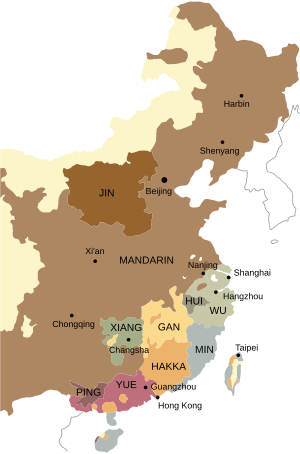Varieties of Chinese facts for kids
Quick facts for kids Chinese |
|
|---|---|
| Sinitic | |
| Ethnicity: | Han Chinese |
| Geographic distribution: |
Mainland China, Hong Kong, Macau, Taiwan, Southeast Asia and other regions with historic immigration from China |
| Linguistic classification: | Sino-Tibetan
|
| Subdivisions: |
Jin
Hui
Xiang
Min
Ping
|
| ISO 639-5: | zhx |
 Primary branches of Chinese according to the Language Atlas of China
|
|
Chinese is a branch of the Han-Tibetan language family. It has hundreds of local languages, many of which are not mutually understandable. There is more variation in the mountainous southeast. There are main seven groups: Mandarin, Wu, Min, Xiang, Gan, Hakka and Yue. But more research is being done.
Chinese varieties differ most in their phonology (sounds), but have similar vocabulary and syntax (grammar). Southern varieties tend to have fewer initial consonants but more often preserve the Middle Chinese final consonants. All have tones. Northern varieties have fewer tones. Many have tone sandhi (biandao). Zhejiang coast and eastern Guangdong has some of the most complex patterns.
Standard Chinese is based on the Beijing dialect. Its vocabulary is based on Mandarin group and grammar based on literature in the modern written vernacular. It is the official language of China, one of the four official languages of Singapore, and one of the six official languages of the United Nations.
Contents
History
In 2nd millennium BC, a form of Chinese was spoken in around the Huanghe. It then expanded east across the North China Plain to Shandong and then south towards the Yangzi river valley. It replaced former languages in the south.
During times of unity, people wanted to use a common standard language to make communication easier between people.
Evidence for dialectal variation is found in texts from the Spring and Autumn period (722–479 BC). At that time, the Zhou still defined a standard speech. The Fangyan (1st century CE) studies the differences in vocabulary between regions. Texts from the Eastern Han period also discuss local differences in pronunciation. The Qieyun rhyme book (601) noted wide variation in pronunciation between regions. It wanted to define a standard pronunciation for reading the classics. This standard is called Middle Chinese.
The North China Plain was flat and easy to move around. So people in the north pretty much spoke the same language.
But South China had many mountains and rivers. So it had six major groups of Chinese languages, with great internal diversity, particularly in Fujian.
Modern Standard Chinese
Until the mid-20th century, most Chinese people spoke only their local language. But the Ming and Qing dynasties defined a common language based on Mandarin. It was known as Guānhuà (官話, "speech of officials"). Knowledge of guanhua was essential for a career as a government official.
Until the 20th century, Classical Chinese was the written standard.
The Republic of China replaced as the written standard by written vernacular Chinese, which was based on northern dialects. In the 1930s a standard national language was adopted, with its pronunciation based on the Beijing dialect, but with vocabulary also drawn from other Mandarin varieties. It is the official spoken language of the People's Republic of China.
Standard Mandarin Chinese now dominates public life. The only other Chinese that may be commonly taught in colleges is Cantonese.
The different Chinese languages
Proportions of first-language speakers Mandarin (65.7%)
-
- spoken in northern and southwestern China
- most speakers.
- includes the Beijing dialect, basis for Standard Chinese
- includes the Dungan language of Kyrgyzstan and Kazakhstan (written in Cyrillic script).
- spoken in Shanghai, most of Zhejiang and the southern parts of Jiangsu and Anhui.
- hundreds of different spoken forms, many of which are not mutually intelligible.
- use stops, affricates and fricatives.
- spoken around Jiangxi.
- closely related to Hakka; used to be "Hakka–Gan dialects".
- spoken in Hunan and southern Hubei.
- some varieties significantly influenced by Southwest Mandarin.
- Fujian and eastern Guangdong
- older than Middle Chinese.
- most diverse
- Varieties from the coast of Fujian around Xiamen have spread to Southeast Asia (where it is called Hokkien) and Taiwan (where it is called Taiwanese Hokkien).
- also spoken in Hainan, Leizhou Peninsula, and throughout southern China.
- The Hakka ("guest families") live in the hills of Guangdong, Fujian, Taiwan, and many other parts of southern China. They have also moved to Singapore, Malaysia and Indonesia.
- words end with -m -n -ŋ and endings -p -t -k.
- Guangdong, Guangxi, Hong Kong and Macau
- migrate to Southeast Asia and many other parts of the world.
- The prestige variety and by far most commonly spoken variety is Cantonese, from the city of Guangzhou (historically called "Canton")
- Cantonese is also the native language of the majority in Hong Kong and Macau.
- Use same endings as Hakka
- many tones.
Relationships between groups
These are sometimes divided into three groups: Northern (Mandarin), Central (Wu, Gan, and Xiang) and Southern (Hakka, Yue, and Min).
Southern Group may come from the Yangzi river during the Han dynasty (206 BC – 220 AD). This is sometimes called the Old Southern Chinese.
The Central group was transitional between the Northern and Southern groups.
Images for kids
-
A school in Guangdong with writing "Please speak Standard Chinese. Please write standard characters" on the wall.



